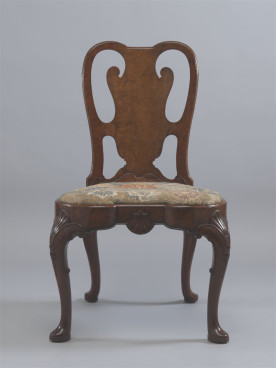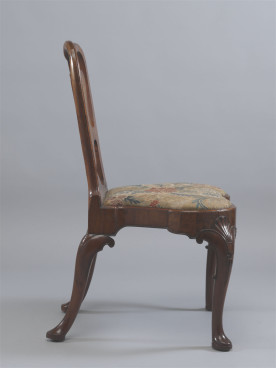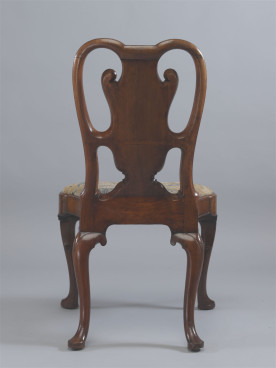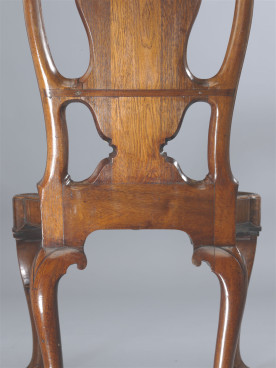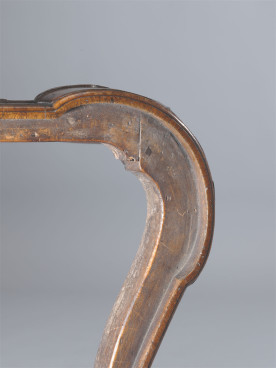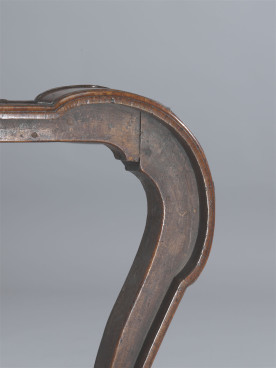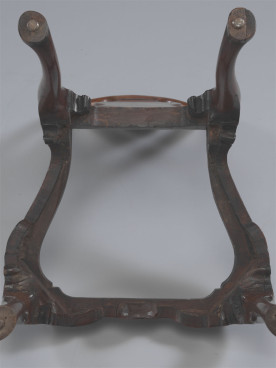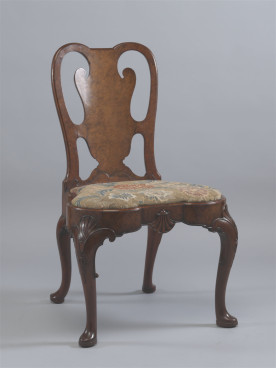Chair, c.1735–45
Walnut, now with 18th-century needlework
This chair is one of a pair from a larger set.
Adam Bowett Catalogue (19/08/2012)
Description
A pair of walnut chairs, c.1735. The scrolled and waisted backs have shaped vase splats linked to the uprights and veneered with burr walnut, over a slip seat covered with needlework. The compass seat has a recessed front centred by a dropped scallop shell, raised on cabriole legs headed by carved scallop shell with pendant of bellflowers. The ogee back feet have pad feet.
Dimensions
H: 37 ¾ ” (96cm) Seat height: 17 ¾” (44cm) W: 22” (56cm) D: 22 ½ “ (57cm)
Materials
Walnut, beech, various upholstery materials.
Dating criteria
A typical 1730s chair, with a similar seat to one shown on the trade card of John Brown, who traded in St Paul’s churchyard from c.1730.
Construction
The back post and legs are solid walnut, thicknessed above the seat to create additional curvature on the inside only. The crest rail is mortised on to the back posts. The splat is solid walnut, constructed in three sections, joined longitudinally, and the link to the back posts is created with a single piece of solid walnut with the grain aligned vertically to match the splat and corresponding post. The whole assembly is strengthened by a strip of walnut approximately half an inch wide, keyed into the entire width of the back. There is no separate shoe; the splat is tenoned directly into the seat rails and shaped to blend with it. The whole of the front face of the back is veneered with burr walnut and edged with a cross-grained ovolo, with further cross-grained edging around the entire outer edge of the back. The appearance of a shoe is given by an additional layer of veneer at the base of the splat. The back seat rail is solid walnut, shaped to provide extra depth to the tenons into the back post. The other seat rails are beech; side rails are tenoned into the back rail, the joint being give additional strength by thicknessing pieces glued to the lower edge of each rail. The side rails are fixed to the front rail with half lapped joint, fixed by two pegs. The deep rebate for the slip seat is created by an applied strip of oak, faced with a moulding of cross-grain walnut. The outer faces of the seat rails are veneered with burr walnut and the lower edges are finished with an applied cock bead. At the centre of the front rail the dropped scallop shell is supported behind by a shaped walnut glue block. The forelegs are dovetailed up through the lapped seat rails, the top of the dovetail being just visible behind the applied edge moulding. The legs are supported by shaped brackets with substantial shaped blocks behind which fit snugly around the top of the leg, fixed with glue and iron nails. The rear legs also have supporting scrolled brackets, and probably originally also had further supporting blocks.
The slip seat frame has side and front rails of oak and back rail of beech, tenoned at the back and lapped at the front.
Marks or stamps
31.1 – Front seat rail is marked I. The corresponding position on the slip-in seat is also marked I.
31.2 – Front seat rail is marked V. The corresponding position on the slip-in seat is marked IIII.
Condition
31.1 – Substantially sound, both joints between crest rail and back post re-pegged. Fractures to the linking pieces of the splat on both sides. It is evident that the reinforcing strip across the back is not original and it has been further strengthened with a screw to each side (but see comments for 31.2). There are also repaired breaks at the base of the splat adjacent to the back posts, some movement to the veneers on the splat and around the edge of the back, ditto around the edges of the seat. Stress cracks are also associated with both front legs where they join the seat rails.
31.2 – Substantially sound, repair to joint between top-rail and left back-post, some worm damage visible to splat left, back post, left back leg and back rail. Stress fractures to the veneers visible on link pieces to the splat. Unlike 31.1, the key slip reinforcing the back of the splat is original.
Additional remarks
A very well made chair of simple design but unusually good quality. Compare with cat no 21.
Provenance
Christie’s London, June 1984, Purchased by G. Randall.


